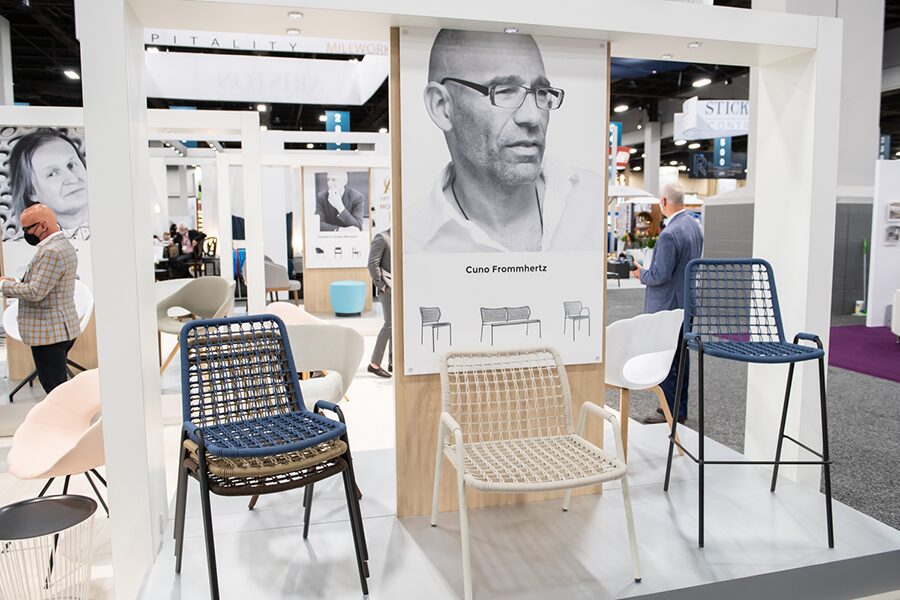For public and private organizations with special events like graduations and performances requiring a stage, complying with the Americans with Disabilities Act (ADA) can be a challenge. While permanent access ramps are typically chosen for new construction or retrofit projects, many schools, universities, and community centers built before the ADA took effect in 1990 can ill afford the structural changes and facility downtime that such a ramp access project can require.
Temporary ramps, one alternative to a full retrofit, have their own drawbacks. They can be unsightly, require more space than may be available at the event or in storage, and require several man-hours to set up and take down with each use. Temporary ramp materials are also heavy and difficult to move, set up, and take down.
Both permanent and temporary access ramps require 1 foot of horizontal run for every 1 inch of vertical elevation (a 1:12 slope), plus a 5-foot landing for every 30 feet of horizontal run. Therefore, it takes 65 feet of linear ramp to safely access a stage 60 inches high. The space taken up by any access ramp greatly reduces the amount of useable floor space in any public facility.
Although permanent wheelchair lifts are an option, these simple elevator-like platforms still require alterations to the building structure and are limited to just one location.
Instead, a more flexible and increasingly popular choice that satisfies ADA requirements is the portable wheelchair lift, which raises and lowers vertically like a permanent lift but can be moved as needed to multiple locations and even used with portable stages.
“Without our portable wheelchair lifts, we wouldn’t be able to meet ADA requirements,” says Lynda Reinhart, director of the Stephen C. O’Connell Center at the University of Florida in Gainesville. “We’re required to provide stage access, but the ramp size we’d need to get people on and off the stage would be space prohibitive. A permanent wheelchair lift wouldn’t work since we use a portable stage for events ranging from graduations and banquets to concerts and trade shows.
“To feel a part of the celebration or program, everyone needs access to the stage,” adds Reinhart. “At graduation, for instance, everyone needs the opportunity to cross the stage and shake hands with their university president or high school principal, regardless of disability.”
The Stephen C. O’Connell Center had previously used portable wheelchair lifts to provide stage access to those with disabilities, but their old lifts were outdated and no longer functioning well.
When Reinhart and the university’s selection committee began the search for new portable wheelchair lifts, aesthetics, portability, safety, value, and long-term reliability were key issues to them.
“Because the stage is the center of attention at graduation ceremonies and other events, the aesthetics of the portable wheelchair lifts were important to us,” says Reinhart. “Our old wheelchair lifts had towers that partly obstructed the audience’s view of the stage. They drew unwanted attention with an out-of-place industrial look. We wanted better.”
Many portable lifts use a machine tower to house the drive mechanism. Since such towers typically exceed 72 inches in height, they can block a clear view of the stage.
Reinhart and the university’s selection committee turned to portable wheelchair lifts by Ascension, a Tucson, Arizona-based manufacturer of portable and permanent wheelchair lifts. “Since their portable wheelchair lifts have no obstructive towers, the audience has a clear view of the stage,” says Reinhart. “They’re very low profile so they blend in with the stage and can be used unobtrusively when an event is in progress.”
Another aesthetic and space-saving plus is that such a portable wheelchair lift can require only 5-1/2 feet of linear space in use, replacing up to 65 feet of linear ramp (for a 60 inch stage).
Ease of portability was essential because the portable wheelchair lifts would often be moved in and out of storage to be used at various events. Because of the range of stage venues the lifts would be used in, quick adjustment to a variety of stage heights was also important.
Reinhart and the university’s selection committee are pleased with their choice of portable wheelchair lifts. “It was vital to us that the Ascension wheelchair lifts were designed for portability from the ground up, and not just permanent lifts with wheels attached to the undercarriage,” says Reinhart. “Their larger casters make them extremely portable, and they can be set up at any height in a matter of minutes. “We could use them anywhere on campus because they’re really mobile.”
Of course, safety and ease of use were crucial to their selection. “Transparent sidewalls and gates on the lift platform offer passenger protection plus a clear view of the stage and their surroundings,” says Reinhart. “A safety skirting completely encloses its operating components during operation, and a stage adjustment device and hinged dock plate make for a smooth transition between the lift and stage.”
Because each portable wheelchair lift has a control panel both inside and outside the lift, it offers operational flexibility in keeping with the spirit of ADA inclusiveness. “A passenger can operate the lift themselves with the control panel inside the lift, or, if needed, a dedicated operator can operate the lift from outside,” says Reinhart.
To get the most from their investment, Reinhart and the university’s selection committee saw value in Ascension’s 20-year warranty on each portable wheelchair lift’s drive train, plus five years on all other parts. “It was important to us to purchase a lift designed to last 20 years,” says Reinhart. “When you make an investment, you want it to last.”
While some public and private stages rise to a full 60-inch height, most stages are substantially lower, particularly at the elementary school level. For those needing a portable wheelchair lift with up to a maximum lifting height of 42 inches, Ascension offers a new portable wheelchair lift at a lower cost, called the Prodigy Model Series. This low-rise wheelchair lift is fully portable and can be easily moved by one person for simple, quick event setup, providing access to stages, platforms, risers, and other elevation changes.



